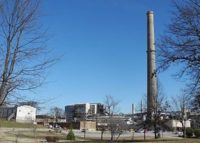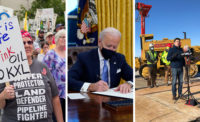Industry consolidation continued in 2016 at a steady but slower pace—with global economic and political trends pushing caution and no blockbuster linkages like those two years earlier.
"We're looking at the first year-over-year decline in industry [merger and acquisition] activity in three years," said design-sector management consultant Morrissey-Goodale. "A combination of factors including uncertainty around the presidential election and mixed messages on the economy conspired to make this latest 12 months of industry consolidation the slowest since 2013."
But the still strong need for the right skills at the right time to execute both projects and corporate growth pushed many companies toward the expediency of "buying" critical talent. Fueled by strengthened post-recession financials and available cash, industry sellers "were looking to capitalize," says company principal Mark Goodale.
Outside investors' money helped fuel deals that firms hope will offer an edge as oil prices eke upward and the incoming Trump administration reveals details of its much-touted plans for more infrastructure investment and less regulation.
Donald Trump's election brought a big bounce to stocks of some major AEC firms, but it's uncertain whether changed power in Washington—and in London after last year's Brexit vote—will sustain that.
Management consultant Steven Gido of Rusk O'Brien Gido said in a report last month that while M&A activity among publicly-traded firms was "somewhat quiet … private equity- backed A/E and environmental firms continued to recapitalize, acquire new platforms and add niche targets to existing portfolio companies." But he pointed to predictions that a recession could still be coming and that some industry executives "privately express [that] their firm’s growth and profitability levels are topping out."
Some noteworthy sector deals did occur last year. In a nearly $800-million deal, publicly-traded Canada design firm Stantec bought privately held US water giant MWH, broadening market and geographic competition for both. Construction payment tech provider Textura Corp. inked a $663-million sale to database giant Oracle, which has combined the firm with the Primavera software unit it owns to expand the new parent's push into engineering and construction.
Buildings giant Structure Tone opened firm ownership beyond its founding families last month for the first time in 40 years, inviting new investment from four outside executives and up to 40 or so key employees.
But other intended megadeals went awry or still must push past regulatory or other hurdles. U.S. construction equipmaker Terex Corp. spent half of the year going back and forth with Finnish and Chinese suitors on merger deals that did not pan out. Paint manufacturing giant Sherwin-Williams Co. still hopes to complete next year purchase of rival Valspar Corp., an expected $11-billion deal begun this past year. There is industry and media speculation that the incoming administration may ease the buyer's antitrust roadblocks.
Also still active is a $700-million offer announced last August from China Communication and Construction Co. to buy IDE Technologies Ltd., a leading Israel-based global desalination technology firm. IDE hopes the transaction, anticipated to finish next year, will expand options in countries where it could not do business before.
Many in industry will be watching whether and how Spanish alternative energy contractor Abengoa emerges from financial straits that shut down units and projects across numerous market sectors and global locations last year. In early December, the firm's large U.S. subsidiary received American court approval to exit its Chapter 11 bankruptcy, despite strong opposition and legal action from U.S. owners with affected projects. Analysts say the ruling moves the parent closer to achieving a global restructuring.
But similar efforts did not prevent bankruptcies last year of California contractor CC Myers nor of the concession formed by Cintra and Zachry American Infrastructure that developed SH 130, Texas' first public-private partnership.
Employees Matter
Workforce issues continue to fuel industry strategic decisionmaking. "Businesses’ biggest problem in 2017 won’t be weak sales, soft pricing, or even too much regulation, all problems that have plagued companies at different times over the past ten years…. their biggest problem ... for the foreseeable future will be a lack of qualified labor," said Mark Zandi, chief economist for Moody's Analytics in a Fortune magazine article late last month.
Rising compensation defined industry trends last year. Carey Peters, executive director of The Construction Labor Research Council, which tracks collective-bargaining, noted more multiyear settlements in 2016, some up to five years, with "bargaining parties feeling more comfortable now" to sign extended pacts.
But union dominance in setting wage rates and labor rules continued to strain, amid growing market pressure, particularly in key urban areas. In New York City, building trades and developers could not agree by a January 2016 deadline on a deal to set prevailing wages on residential construction to continue the city’s tax abatement program for affordable housing, despite intervention from Gov. Andrew Cuomo. It is not clear whether any agreement will be reached in 2017.
In booming Jersey City, N.J., the future of a nine-year-old municipal rule tying city tax abatements to project-labor-agreement wage rates on private projects above $25 million also may be altered after a U.S. appellate court last year upheld a challenge from open-shop firms.
How owners respond to labor force gaps, skill needs and site productivity will be key trends to watch next year. Chris Affuso, director of project execution for Praxair Inc. told ENR in 2016 that these issues "are becoming more critical now,” with skill levels tougher to assess. An executive of the Construction Users Round Table noted that “it is not enough for owners to tell contractors that workforce availability is their problem."
Industry training operations such as NCCER are pushing to boost standards and certifications for workers across trades and regions, and growing interest in skills competitions are refining how workers do their jobs—while offering a skills showcase to employers, owners and potential recruits.
Also drawing industry attention are possible restrictions in immigration laws that could skew employment of trades and alter or kill the existing H-1B skilled worker visa program, reducing populations of foreign engineering students and graduates.
To protect existing forces and reduce liability, worker safety and health programs will continue as company priorities for most firms.
But battle lines will emerge as President-elect Trump, his appointees and the Republican-controlled Congress target in 2017 a slew of Obama administration workforce rules that firms say are too costly, but that employee advocates are determined to preserve.
Poaching Still Popular
Employers continued to raid each other's executive ranks for needed talent, although some reached into new sectors for leadership, such as defense contracting and technology—something advocated by Brendan Bechtel, new CEO of Bechtel Group, in remarks to an ENR conference audience last September.
Diversity got a boost last year when Caterpillar named Denise Johnson, a 22-year GM veteran, to group president of its mining-focused resources-industries segment, and Bevlee Watford, associate dean for academic affairs at Virginia Tech’s College of Engineering, become the first black woman named president-elect of the American Society for Engineering Education. These were among growing efforts by firms to develop the best talent, particularly in the growing ranks of millenials.
Facing continued market uncertainties, new CEOs took over last year, or will in early 2017, at engineers WSP Global, Kleinfelder and North American units of Atkins and ARCADIS NV; also at contractors Kiewit, Railworks, and M.A. Mortenson Co., and at equipment manufacturer giant Caterpillar Inc. But CEOs at ARCADIS NV corporate in Holland and Minneapolis building contractor Adolph & Peterson Construction exited last month in apparent corporate strategy disputes with their respective boards of directors.
Montreal giant SNC Lavalin continues its push for growth and transparency five years after a corruption scandal rocked the firm, its AEC peers and the Canadian business community. But despite a strengthened ethics platform and agreements with government entities, legal issues arising from the crisis may not resolve for two more years.
Ethics crises also took their toll at other firms last year. Architecture firm CannonDesign paid $12 million to resolve criminal liability in a bribe scheme involving a former executive, other employees and an ex-Dept. of Veterans' Affairs manager; executives of New York contractor LPCiminielli face upcoming trials in a pay- to-play scheme in New York state.
Ongoing industry corruption impacts in Brazil played out last year at the August Olympic Games in Rio de Janeiro, and in a late December agreement under which Brazilian contractor Odebrecht and its petrochemical affiliate Brexem will pay $3.5 billion to resolve violations of US foreign bribery law following a nearly three-year investigation in Brazil dubbed "Operation Car Wash."
Cyber-security risks facing business became personal to French contractor giant VINCI in 2016 when its shares plunged suddenly in late November, but then recovered, after a negative fake news report appeared on its website and triggered market jitters.
Also personal to firms and to the industry were the losses of key pacesetters and visionaries who died last year. They include ENR Editor-in-Chief Emeritus Arthur J. Fox; noted structural engineer Vincent J. DeSimone; earthquake experts Vitelmo Bertero and Raymond Clough; construction management pioneer John Tishman; Robert Kiley, who oversaw the revival of three major urban public-transit systems in the U.S. and U.K.; and Susan M. Baer, 65, an aviation-sector pioneer who was the first woman aviation director at the Port Authority of New York & New Jersey.
But, with iPad in hand, Bechtel's new 35-year-old CEO, the fifth-generation of the family-founded firm to run it, spoke optimistically of the future and urged attendees at ENR's Global Summit to find new ways “to increase our relevance.”
Stressed Brendan Bechtel: “The most successful firms will define change, not respond to it."





